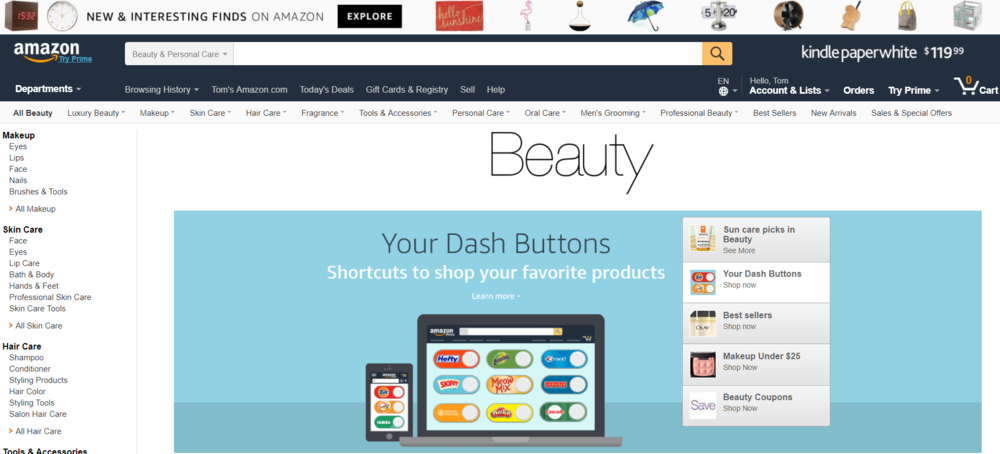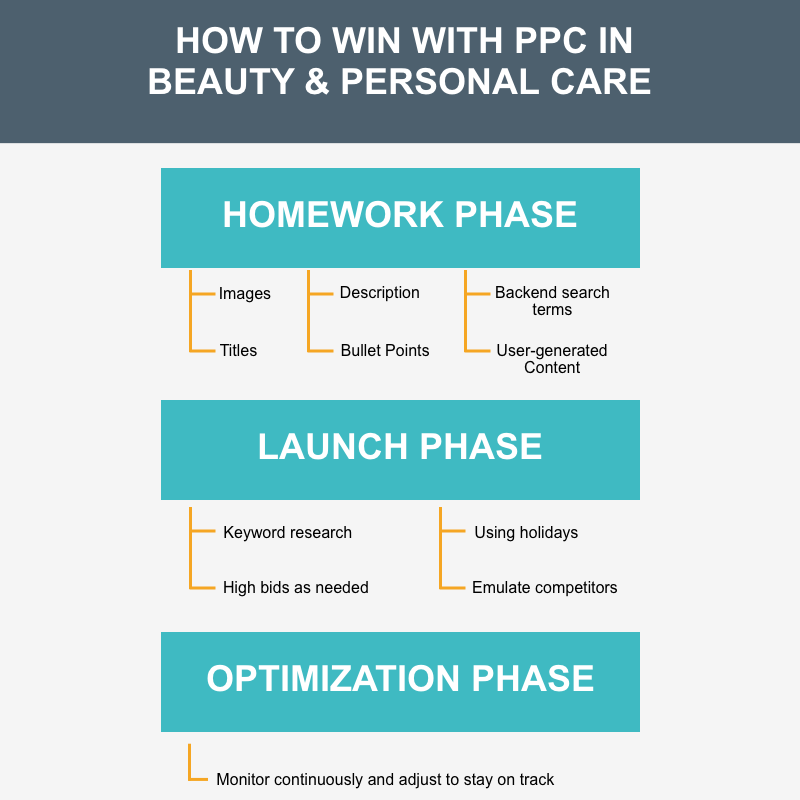The Beauty & Personal Care category is one of the most exciting areas on Amazon. It has huge sales potential, which is why sellers continually approach Bobsled about offering products in this category. Whenever we work with clients in Beauty & Personal Care, it’s always a pleasure and Bobsled team members are eager to jump in. Our shared sense of excitement about the category is exactly what inspired this post. We’re eager to share what we’ve learned.

The specific steps you need to take when setting up and optimizing pay-per-click (PPC) campaigns in Beauty and Personal Care seem to fall into three phases. For maximum efficiency, each of these phases should be complete before you move on to the next:
-
Homework Phase
-
Launch Phase
-
Optimization Phase
Let’s dive into the details of each.
Doing your homework before launching PPC campaigns
PPC is never the first step because it can’t be successful until it has something to work with. You need to make every effort to set up and optimize your product listing page before you turn to advertising. Directing traffic to product listings that aren’t ready defeats the purpose of advertising.
Instead, you should remember that PPC is a tool meant to deliver highly-relevant traffic to your product listing. Conversion, which is when a visitor to your page goes from prospective customer to paying customer, is not the task of PPC. The ad gets the customer to your page, but it doesn’t make them buy. The listing is what must earn the conversion.
To get your listing ready for PPC, here are the elements to consider:
Images: Images play a huge role in the beauty category. Make sure you include clear, professional images of your product on a white background and a picture of the product’s packaging with a white background, as well as some images of the product in use (e.g., an illustration of how a certain makeup item is applied). We definitely recommend you use all the image slots that Amazon gives you.
Title: We recommend that you identify the 3-5 best keywords and figure out a way to include them in the title. Don’t worry if you end up with a title that is quite long!
Bullet Points & Description: These are great places to list your highest-volume keywords. Make sure you fill out all the bullet points available, trying to connect the features of your product to the benefits it will provide to the customer.
User-Generated Content: Millennials tend to trust user-generated content more than anything that might be in an advertisement. (That’s why product reviews are so important on Amazon in the first place.) You should take whatever reasonable measures you can to increase the odds of your customers engaging with your product—leaving reviews, posting photos of it online, talking about their purchase, etc.
Backend Search Terms: This step actually falls between the homework phase and the launch phase. Just pick the most relevant keywords and create a long string of characters with only spaces between words, no commas or semicolons. Ideally, this list will be the result of your keyword research.
Unlike with the image slots, this is where we’d recommend you avoid using all the fields Amazon makes available. A keyword string with your most relevant keywords—between 250 and 400 characters long, let’s say—should be enough.
We recommend this because Amazon does not index all of the 5,000 characters allowed across the five search fields you have to work with. In fact, there is a heated debate among PPC experts about just how many characters actually get indexed, but everyone agrees it’s fewer than 1,000 characters. Most likely, this is more than enough for capturing relevant terms. Include any more than this and you’ll either be duplicating keywords or adding less-relevant keywords that might do you more harm than good.
Launching PPC Campaigns
We have written about PPC optimization in a number of previous Bobsled blog posts. If you are interested in learning more about PPC in general, please check out those articles. Here, we are only going to cover tactics related to the Beauty & Personal Care category. Keep the following tips in mind for your launch:
Perform extensive keyword research: As you can imagine, this category is extremely competitive, which has caused cost-per-click (CPC) rates to go quite high. That’s why it’s important to home in on your best-performing keywords. You’ll be wasting your resources if you spend money on irrelevant or poorly-performing keywords.
Be prepared to bid high: Again, this category is very competitive. Bids can go all the way up to $5 per click on some items, so you have to consider this cost when determining your weekly and monthly PPC budgets. You should be prepared to go over the bid suggested by Amazon.
Use holidays to your advantage: Most of the products in the Beauty & Personal Care category make great gifts for Valentine’s Day, Mother’s Day, and even during the summer season. Make sure you check your calendar often and prepare for gift-giving holidays well in advance—you will probably want to launch a thematic campaign at least several weeks before each holiday.
Steal: I don’t quite feel comfortable recommending this, but all's fair in love and Amazon, right? Taking a close look at your competitors and running reverse ASIN keyword research can turn out to be quite helpful, especially with competitors who’ve been on Amazon longer than you have. Chances are that they’ve already invested in research and have identified customer search term patterns that may work for you as well!

Optimize, optimize optimize
Once you’ve done your homework and launched your campaign, the third phase, optimization, is going to be a matter of continual monitoring. There’s no single approach that will guarantee great results every time. That’s just not how it works.
There will always be some predictions that fail to deliver. Some competitor keywords simply won’t work for you. Some keywords won’t gain traction even if you bid twice the amount of the recommended bid. Therefore, you should think of optimization as something to continually adjust so your unique campaign doesn’t drift off course.
As your campaign progresses, you will need to dig deep into your account several times a week, keeping track of which keywords are working well and making decisions about what to cut and what to keep.
To sum up, the Beauty & Personal Care category on Amazon is a tremendous selling opportunity for any brand in the space. It’s exciting, it’s competitive, and it’s profitable. If that sounds like what you’re looking for (and why wouldn’t you be?), get in touch with Bobsled. We love helping clients succeed in this category!
.png)

